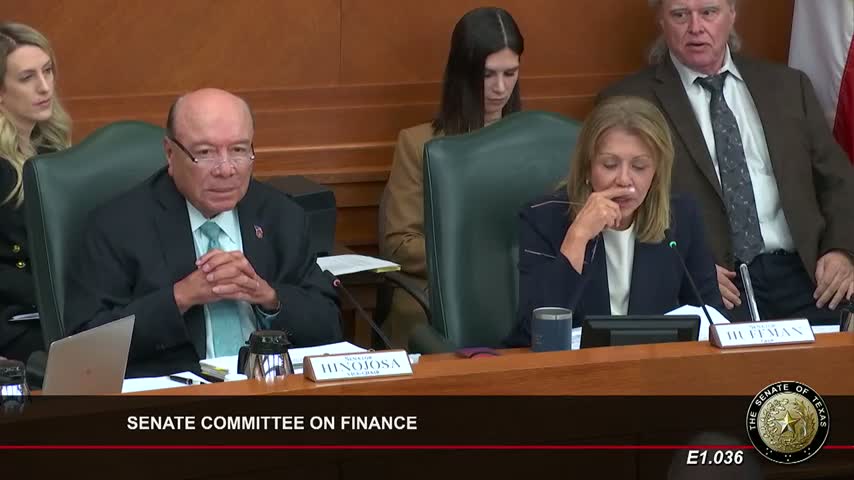Texas Senate committee reviews record $51 billion property tax relief plan amid rising costs
January 27, 2025 | Senate, Legislative, Texas
This article was created by AI summarizing key points discussed. AI makes mistakes, so for full details and context, please refer to the video of the full meeting. Please report any errors so we can fix them. Report an error »

In a pivotal meeting of the Texas Senate Committee on Finance, lawmakers gathered to dissect the complexities of property tax relief, a pressing issue for many Texans. The atmosphere was charged with anticipation as committee members prepared to delve into the details of Senate Bill 1 (SB1), which promises significant changes to property tax structures.
Aaron Hendrickson from the Legislative Budget Board opened the discussion with a comprehensive overview of the property tax relief measures enacted by the previous legislature. He highlighted that the 88th Legislature had appropriated a staggering $18 billion in property tax relief, a figure that has now ballooned to an estimated $22.7 billion due to rising property values and various legislative adjustments. This increase, while beneficial for taxpayers, poses challenges for future budgeting and funding commitments.
The committee members engaged in a robust dialogue about the implications of these changes. Senator Perry raised concerns about the sustainability of the funding, noting that the state’s commitment to property tax relief could lead to significant shortfalls if not managed carefully. He emphasized the need for a long-term projection to understand how these financial obligations might evolve over the next decade.
As the discussion unfolded, it became clear that the interplay between local and state funding mechanisms complicates the narrative around property taxes. Senator Campbell pointed out that while the state works to alleviate school-related property taxes, local municipalities continue to levy their own taxes, which can negate the relief efforts. This duality highlights the intricate relationship between state policies and local governance, where decisions made at the local level can significantly impact taxpayers' overall burden.
The committee also touched on the effects of federal COVID-19 funding, which has provided temporary relief but is tapering off. Hendrickson noted that while Texas received approximately $86 billion in federal aid, much of it was earmarked for one-time projects, leaving the state to grapple with ongoing funding needs as the pandemic's economic impacts linger.
As the meeting drew to a close, the committee members acknowledged the monumental task ahead. With a record property tax relief package on the table, they must navigate the complexities of funding, local tax policies, and the expectations of Texas residents. The discussions underscored a critical point: while the state can provide relief, the responsibility ultimately lies with local governments to manage their tax rates effectively.
In the coming months, as the legislature continues to refine SB1 and other related measures, the implications of these discussions will resonate throughout Texas, shaping the financial landscape for residents and local governments alike. The committee's work is far from over, and the stakes remain high as they strive to balance relief with fiscal responsibility.
Aaron Hendrickson from the Legislative Budget Board opened the discussion with a comprehensive overview of the property tax relief measures enacted by the previous legislature. He highlighted that the 88th Legislature had appropriated a staggering $18 billion in property tax relief, a figure that has now ballooned to an estimated $22.7 billion due to rising property values and various legislative adjustments. This increase, while beneficial for taxpayers, poses challenges for future budgeting and funding commitments.
The committee members engaged in a robust dialogue about the implications of these changes. Senator Perry raised concerns about the sustainability of the funding, noting that the state’s commitment to property tax relief could lead to significant shortfalls if not managed carefully. He emphasized the need for a long-term projection to understand how these financial obligations might evolve over the next decade.
As the discussion unfolded, it became clear that the interplay between local and state funding mechanisms complicates the narrative around property taxes. Senator Campbell pointed out that while the state works to alleviate school-related property taxes, local municipalities continue to levy their own taxes, which can negate the relief efforts. This duality highlights the intricate relationship between state policies and local governance, where decisions made at the local level can significantly impact taxpayers' overall burden.
The committee also touched on the effects of federal COVID-19 funding, which has provided temporary relief but is tapering off. Hendrickson noted that while Texas received approximately $86 billion in federal aid, much of it was earmarked for one-time projects, leaving the state to grapple with ongoing funding needs as the pandemic's economic impacts linger.
As the meeting drew to a close, the committee members acknowledged the monumental task ahead. With a record property tax relief package on the table, they must navigate the complexities of funding, local tax policies, and the expectations of Texas residents. The discussions underscored a critical point: while the state can provide relief, the responsibility ultimately lies with local governments to manage their tax rates effectively.
In the coming months, as the legislature continues to refine SB1 and other related measures, the implications of these discussions will resonate throughout Texas, shaping the financial landscape for residents and local governments alike. The committee's work is far from over, and the stakes remain high as they strive to balance relief with fiscal responsibility.
View full meeting
This article is based on a recent meeting—watch the full video and explore the complete transcript for deeper insights into the discussion.
View full meeting
